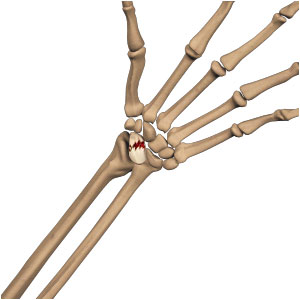What is a Scaphoid Fracture?
The wrist consists of two bones in the forearm, the radius and ulna, and eight tiny carpal bones in the palm. The bones meet to form multiple large and small joints. The scaphoid is a small boat shaped bone in the wrist. It is almost entirely covered in cartilage and has a poor blood supply. It’s function is considered to be of utmost importance to wrist mechanics.
Causes of Scaphoid Fractures
Scaphoid fractures may be caused by a fall on an outstretched hand, vehicular accidents, or workplace injuries. Certain sports such as football, snowboarding or soccer may also be a cause of scaphoid fractures.

Signs and Symptoms of Scaphoid Fractures
The common symptoms of a scaphoid fracture include severe pain, swelling, and limited movement of the hand and wrist. Many patients experience pain over the “anatomical snuffbox,” which is located on the top (dorsum) of the wrist, at the base of the thumb.
Diagnosis of Scaphoid Fractures
A preliminary physical examination followed by imaging tests, such as an X-Ray, will be performed to diagnose a fracture and check the alignment of the bones. Sometimes a CT scan may be ordered to gather more details of the fracture, such as damage to soft tissue, nerves or blood vessels. In some cases, a MRI may also be ordered to identify tiny fractures and ligament injuries.
Treatment for Scaphoid Fracture
Your doctor may prescribe analgesics and anti-inflammatory medications to relieve pain and inflammation caused by a scaphoid fracture.
Fractures that are not displaced can be treated with either a special splint, cast, or brace to hold the wrist and thumb in place. This is called a thumb spica.
Since the bone has a poor blood supply, surgery is often recommended to treat scaphoid fractures. Surgery frequently involves the placement of a screw inside the bone to hold it in place so the body can mend the fracture.
